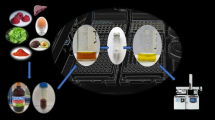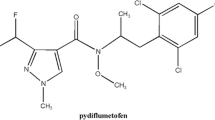Abstract
Pressurized liquid extraction (PLE) was applied to the simultaneous extraction of a wide range of pesticides from food commodities. Extractions were performed by mixing 4 g of sample with 4 g of Hydromatrix and (after optimization) a mixture of ethyl acetate:acetone (3:1, v/v) as extraction solvent, a temperature of 100°C, a pressure of 1000 psi and a static extraction time of 5 min. After extraction, the more polar compounds were analyzed by liquid chromatography (LC), and the apolar and semipolar pesticides by gas chromatography (GC); in both cases LC and GC were coupled with mass spectrometry in tandem (MS/MS) mode. The overall method (including the PLE step) was validated in GC and LC according to the criteria of the SANCO Document of the European Commission. The average extraction recoveries (at two concentration levels) for most of the analytes were in the range 70–80%, with precision values usually lower than 15%. Limits of quantification (LOQ) were low enough to determine the pesticide residues at concentrations below or equal to the maximum residue levels (MRL) specified by legislation. In order to assess its applicability to the analysis of real samples, aliquots of 15 vegetable samples were processed using a conventional extraction method with dichloromethane, and the results obtained were compared with the proposed PLE method; differences lower than 0.01 mg kg−1 were found.




Similar content being viewed by others
References
Granby K, Hinge Andersen J, Bjerre Christensen H (2004) Anal Chim Acta 520:165–176
Stajnbaherm D, Zupancic-Kralij L (2003) J Chromatogr A 1015:185–198
Blasco C, Picó Y, Mañes J, Font G (2002) J Chromatogr A 947:227–235
Sannino A, Bolzoni L, Bandini M (2004) J Chromatogr A 1036:161–169
Sandra P, Tienpont B, David F (2003) J Chromatogr A 1000:299–309
Mool HGJ, van Dam RCJ, Steijger OM (2003) J Chromatogr A 1015:119–127
Garrido Frenich A, Martínez Vidal JL, López-López T, Cortes Aguado S, Martínez Salvador I (2004) J Chromatogr A 1048:199–206
Arrebola FJ, Martínez Vidal JL, González-Rodríguez MJ, Garrido Frenich A, Sánchez Morito N (2003) J Chromatogr A 1005:131–141
Martínez Vidal JL, Arrebola FJ, Mateu Sánchez M (2002) Rapid Commun Mass Spectrom 16:1106–1115
Richter BE, Jones BA, Ezzel JL, Porter NL (2003) Anal Chem 68:1033–1039
Lehotay SJ (1997) J Chromatogr A 785:289–312
Pihlström T, Isaac G, Waldebäck M, Österdahl B-G, Markides KE (2002) Analyst 127:554–559
Adou K, Bontoyan WR, Sweeney P (2001) J Agric Food Chem 49:4153–4160
Obana H, Kikuchi K, Okihashi M, Hori S (1997) Analyst 122:217–220
Lehotay SJ, Lee C-H (1997) J Chromatogr A 785:313–327
Concha-Graña E, Turnes-Carou MI, Muniategui-Lorenzo S, López-Mahía P, Fernández-Fernández E, Prada-Rodríguez D (2004) J Chromatogr A 1047:147–155
Dabrowski L, Giergielewicz-Mozajska H, Biziuk M, Gaca J, Namiesk J (2002) J Chromatogr A 957:59–67
Marchese S, Perret D, Gentili A, Curini R, Marino A (2001) Rapid Commun Mass Spectrom 15:393–400
Hubert A, Wenzel K-D, Manz M, Weissflog L, Engewald W, Schuurmann G (2000) Anal Chem 72:1294–2000
Björklund E, Nilsson T (2000) Trends Anal Chem 19:434–445
EU (2003) Quality control procedures for pesticide residues analysis. Guidelines for residues monitoring in the European Union (SANCO/10476/2003), 3rd edn. European Union, Brussels
EU (2004) Guidance document on residue analytical methods (SANCO/825/rev. 7). European Union, Brussels
EU (1993) Order 93/58/EEC of the Council, 23 August 1993. European Union, Brussels
Acknowledgements
The authors are very grateful to the Town Council of El Ejido (Almería, Spain), and to the Instituto Nacional de Investigación y Tecnología Agraria y Alimentaria (INIA) (Project CAL-03-055) (Spain) for their financial and material support.
Author information
Authors and Affiliations
Corresponding author
Rights and permissions
About this article
Cite this article
Garrido Frenich, A., Martínez Salvador, I., Martínez Vidal, J.L. et al. Determination of multiclass pesticides in food commodities by pressurized liquid extraction using GC–MS/MS and LC–MS/MS. Anal Bioanal Chem 383, 1106–1118 (2005). https://doi.org/10.1007/s00216-005-0139-x
Received:
Revised:
Accepted:
Published:
Issue Date:
DOI: https://doi.org/10.1007/s00216-005-0139-x




